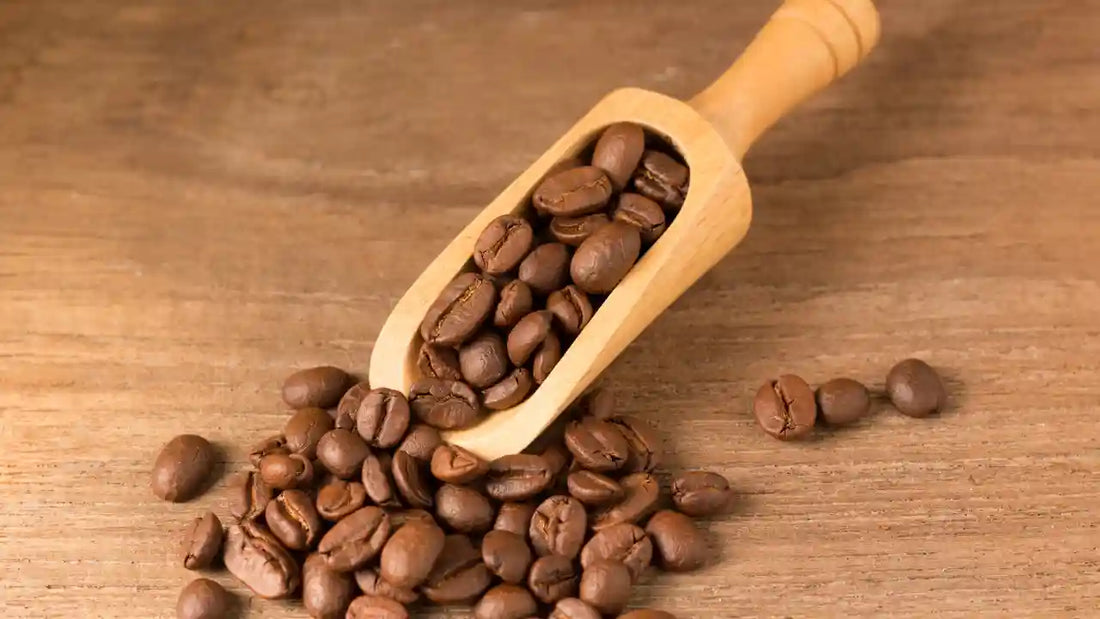
How Long Do Coffee Beans Stay Fresh After Roasting?
Share
Open a freshly roasted bag of coffee beans, and you’re hit with that rich, toasty aroma that makes coffee feel like magic. But have you ever wondered how long that freshness really lasts?
Can you keep a bag around for a month… or two… and still expect great flavor?
The truth is, coffee is a perishable product and just like fresh bread or fruit, it starts to lose its best qualities over time.
While it won’t go “bad” like milk, it absolutely does go stale, and that affects how your cup tastes: dull, flat, sometimes even bitter or sour.
In this guide, we’ll break down:
- How long roasted coffee beans actually stay fresh
- What causes them to lose flavor
- How to store them right
- And how to tell when it’s time to toss that old bag
Let’s make sure your beans stay as flavorful as the day they were roasted, or close enough to it.
What Happens to Coffee After Roasting?
Roasting transforms raw green coffee beans into the aromatic, flavorful ones we all know and love, but that transformation comes at a cost: freshness has a ticking clock.
The Roasting Process
When coffee is roasted, it undergoes a series of chemical reactions that create all those beautiful compounds: the caramel sweetness, nutty warmth, chocolatey depth, or bright fruitiness.
But once the roasting ends, those same volatile compounds start to break down.
The Degassing Phase
Right after roasting, beans release carbon dioxide (CO₂), a natural byproduct of roasting. This process is called degassing, and it usually lasts for a few days.
- That’s why super-fresh beans may taste “tight” or inconsistent if brewed too soon.
- Most specialty roasters, including us at BrewClan, recommend resting beans for 2 to 5 days before brewing for peak flavor.
The Shelf Life Clock Starts Ticking
From the moment roasting ends, oxidation begins. Oxygen, light, moisture, and heat start degrading the delicate oils and aromas that make specialty coffee so nuanced. Over time, the beans go stale, losing vibrancy and depth.
Understanding what happens after roasting is the first step toward preserving that flavor for as long as possible, and knowing when it’s time to move on from an old bag.
The Ideal Freshness Window
There’s a sweet spot when coffee tastes its absolute best and knowing when that window opens (and closes) can completely change how you experience your brew.
Whole Beans
- Peak Flavor: Typically from Day 4 to Day 21 after roasting
- Still Good: Up to 4–6 weeks if stored properly
- Past Prime: After 6–8 weeks, flavors start flattening significantly
Whole beans stay fresh longer because the oils and aromatics are still sealed inside. This makes them the best choice if you want consistent, vibrant flavor over time.
Ground Coffee
- Peak Flavor: Within minutes to a few days
- Past Prime: Starts losing complexity almost immediately due to high surface area exposure
Grinding increases contact with oxygen dramatically, so if you buy pre-ground coffee, try to use it up quickly and store it with extra care.
The Myth of “Fresh Is Always Better”
Interestingly, coffee isn’t always at its best immediately after roasting. Freshly roasted beans need 2–5 days to de-gas, during this time, the CO₂ they emit can interfere with proper extraction, especially in manual brewing methods like pour-over or espresso.
💡 The sweet spot for brewing is usually between Days 5–21 when the bloom is lively, aromatics are peaking, and flavor balance is optimal.
Factors That Affect Coffee Freshness
Even the freshest roast won’t last long if it’s exposed to the wrong elements. Coffee is incredibly sensitive, and these four culprits are the biggest reasons your beans might go stale faster than expected:
1. Air (Oxygen Exposure)
Once exposed to oxygen, coffee begins to oxidize, a chemical process that breaks down aromatic oils and flavor compounds.
→ This leads to dull, flat, or bitter coffee.
✅ Solution: Store beans in an airtight, resealable bag or container.
2. Light
Sunlight (or even strong indoor light) degrades compounds in roasted beans, especially the oils on darker roasts.
→ Beans can take on a bleached look and lose their depth of flavor.
✅ Solution: Use opaque bags or containers. Never store beans in a glass jar on the counter.
3. Heat
Warm temperatures accelerate chemical reactions, including staling.
→ Heat essentially “ages” your beans faster.
✅ Solution: Store beans in a cool, dark cupboard away from the stove, oven, or direct sunlight.
4. Moisture
Coffee is hygroscopic, it absorbs moisture from the air.
→ This can lead to mold, clumping, and muted flavors.
✅ Solution: Always seal bags tightly after use. Never refrigerate opened coffee bags (fridges are humid).
5. Grind Size (Bonus Factor)
The finer the grind, the more surface area is exposed to air, which means ground coffee stales much faster than whole beans.
✅ If possible, grind only what you need just before brewing.
Signs Your Coffee Has Gone Stale
Not sure if your beans are past their prime? Your senses will tell you, if you know what to look (and smell, and taste) for.
Here are the most common signs of stale coffee:
1. Weak or Flat Aroma
Fresh coffee beans have a rich, punchy aroma when you open the bag - nutty, fruity, chocolatey, floral, depending on the roast.
→ If your coffee smells dull, dusty, or like cardboard, it’s likely stale.
2. Dull, Muted Flavor
Fresh beans produce vibrant cups with depth and character.
→ If your coffee tastes flat, hollow, or “lifeless” no matter how well you brew it, staleness is a likely culprit.
3. No Bloom While Brewing
When you pour hot water over fresh coffee (especially in pour-over or French press), it “blooms” bubbling as trapped CO₂ escapes.
→ No bloom = beans are likely too old and have already released their gases.
4. Oily Beans Turn Dry or Dusty
With time, the oils on the surface of roasted beans evaporate or absorb moisture.
→ Beans that once looked glossy now seem pale, dry, or flaky? That’s a sign they’ve aged past their prime.
5. Inconsistent Taste
You might notice bitterness, sourness, or a confusing mix of flavors in the cup, all indicators of degraded aromatic compounds.
💡 Pro tip: If your brew suddenly tastes off and you haven’t changed your method, water, or grinder - it’s probably the beans.
How to Extend Coffee Shelf Life
Freshness doesn’t last forever, but smart storage can buy you more time, without sacrificing flavor. Here’s how to make every bag last longer (and taste better, longer):
1. Keep It Airtight
Oxygen is the #1 enemy of freshness.
→ Always reseal your bag tightly or transfer beans to an airtight container if the original bag isn’t resealable.
2. Use Opaque, Light-Proof Packaging
Light breaks down the flavorful oils and aromatic compounds.
→ Store coffee in a dark, non-transparent bag or container. Avoid glass jars unless they’re stored in a cupboard.
3. Avoid Heat and Moisture
Store your coffee in a cool, dry place, not the fridge (too humid) and definitely not near your stove or oven.
4. Grind Just Before Brewing (if possible)
Whole beans retain their freshness much longer than ground coffee.
→ Grinding just before brewing preserves flavor and aroma, but if you buy pre-ground, use it within 1–2 weeks and store it extra carefully.
5. Freeze Beans — Carefully (Optional)
Only freeze whole beans and only if you’re storing in bulk.
- Divide into small airtight portions
- Don’t open and refreeze; condensation will ruin the beans
- Thaw completely before opening the container
💡 Most home brewers are better off buying smaller amounts more frequently rather than freezing.
Quick Reference Chart: Coffee Freshness Guidelines
|
Coffee Form |
Peak Freshness |
Still Tastes Good Up To |
Storage Tips |
|---|---|---|---|
|
Whole Beans |
Day 5 to Day 21 |
4–6 weeks |
Resealable bag, cool dark place |
|
Pre-ground Coffee |
1–3 days |
1–2 weeks |
Airtight container, use quickly |
|
Espresso Roast |
Day 7 to Day 30 |
Up to 6 weeks |
Slightly longer degassing period needed |
|
Frozen Whole Beans |
After thawing |
1–2 months post-freeze |
Freeze in sealed, portioned bags only |
BrewClan’s Approach to Freshness
At BrewClan, we take freshness seriously, because we know that even the best beans lose their magic without it.
That’s why we roast our coffee in small batches throughout the week, not in massive bulk runs. It allows us to ship your coffee within days of roasting, so you receive it right in that sweet spot of peak flavor.
We also pack every order in a resealable, air-tight, opaque pouch, no need to transfer it to another container. Just open, reseal, and store it in a cool, dark place. Simple.
And since our beans are specialty-grade, freshness isn’t just a bonus, it’s essential. The brighter acidity, nuanced sweetness, and delicate aromas you get in a cup of BrewClan coffee? They’re only possible when the beans are truly fresh.
👋 If you’ve never tried coffee roasted with this level of care, start with just one bag.
You might never go back to shelf coffee again.
→ Explore Our Freshly Roasted Coffees
FAQs - Frequently Asked Questions
1. How long do coffee beans stay fresh after roasting?
Whole beans are at their peak between days 5–21 after roasting and remain usable for 4–6 weeks if stored properly.
2. Can I still use coffee beans after a month?
Yes, but they may lose complexity and taste dull or flat. For best flavor, consume beans within 4–6 weeks of roasting.
3. How can I tell if coffee beans are stale?
Stale beans have a flat aroma, no bloom during brewing, dry appearance, and muted or bitter flavor.
4. Should I refrigerate or freeze coffee beans?
Avoid the fridge. You can freeze whole beans only if properly portioned, sealed airtight, and thawed before opening.
5. Do ground coffee beans go stale faster than whole beans?
Yes, ground coffee oxidizes quickly due to more surface area. It’s best used within a few days of grinding.
6. What’s the best way to store coffee beans?
Keep beans in a resealable or airtight container in a cool, dark place. Avoid air, heat, light, and moisture.
7. What is degassing in coffee?
Degassing is the release of carbon dioxide (CO₂) from freshly roasted beans, typically over 2–5 days after roasting.




